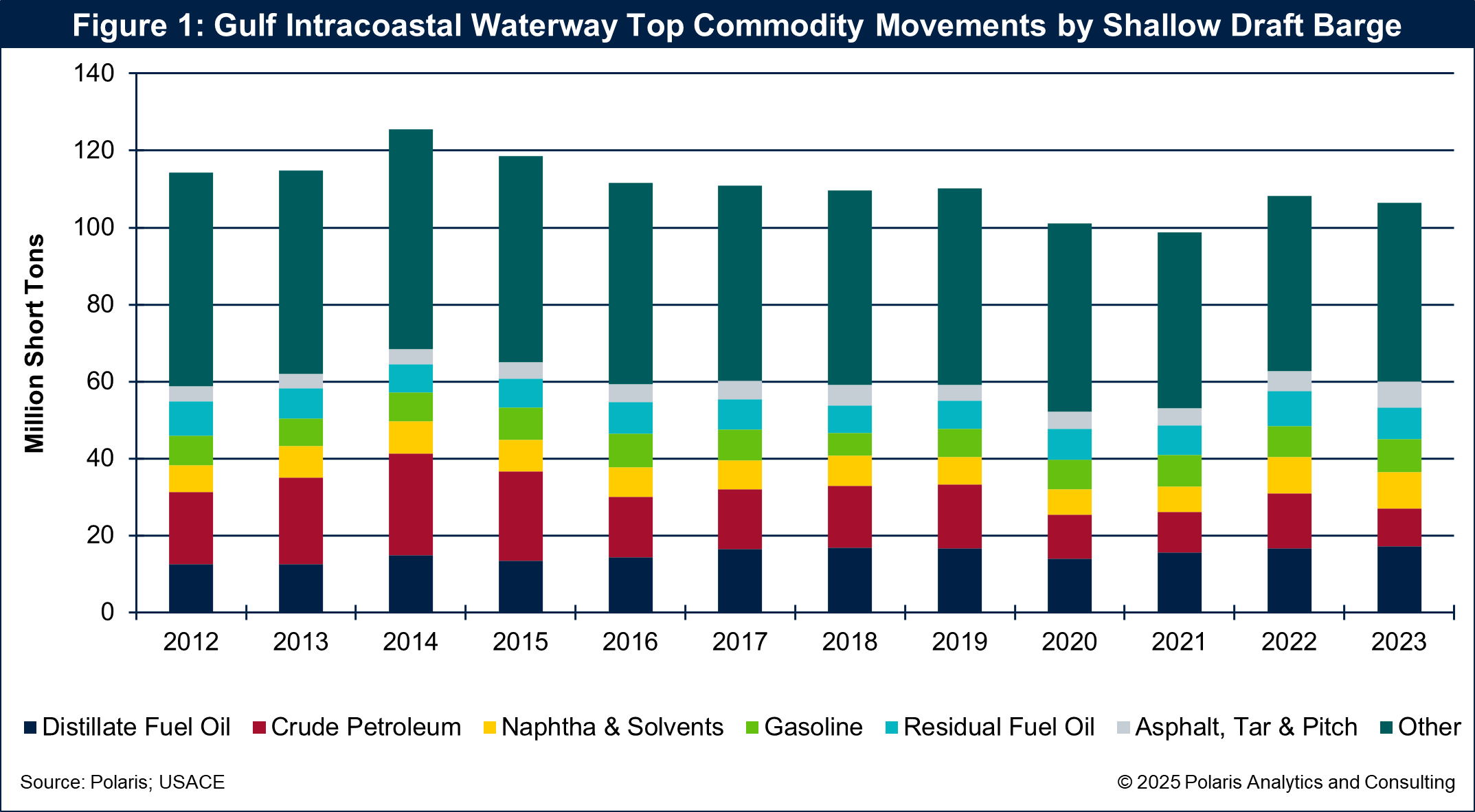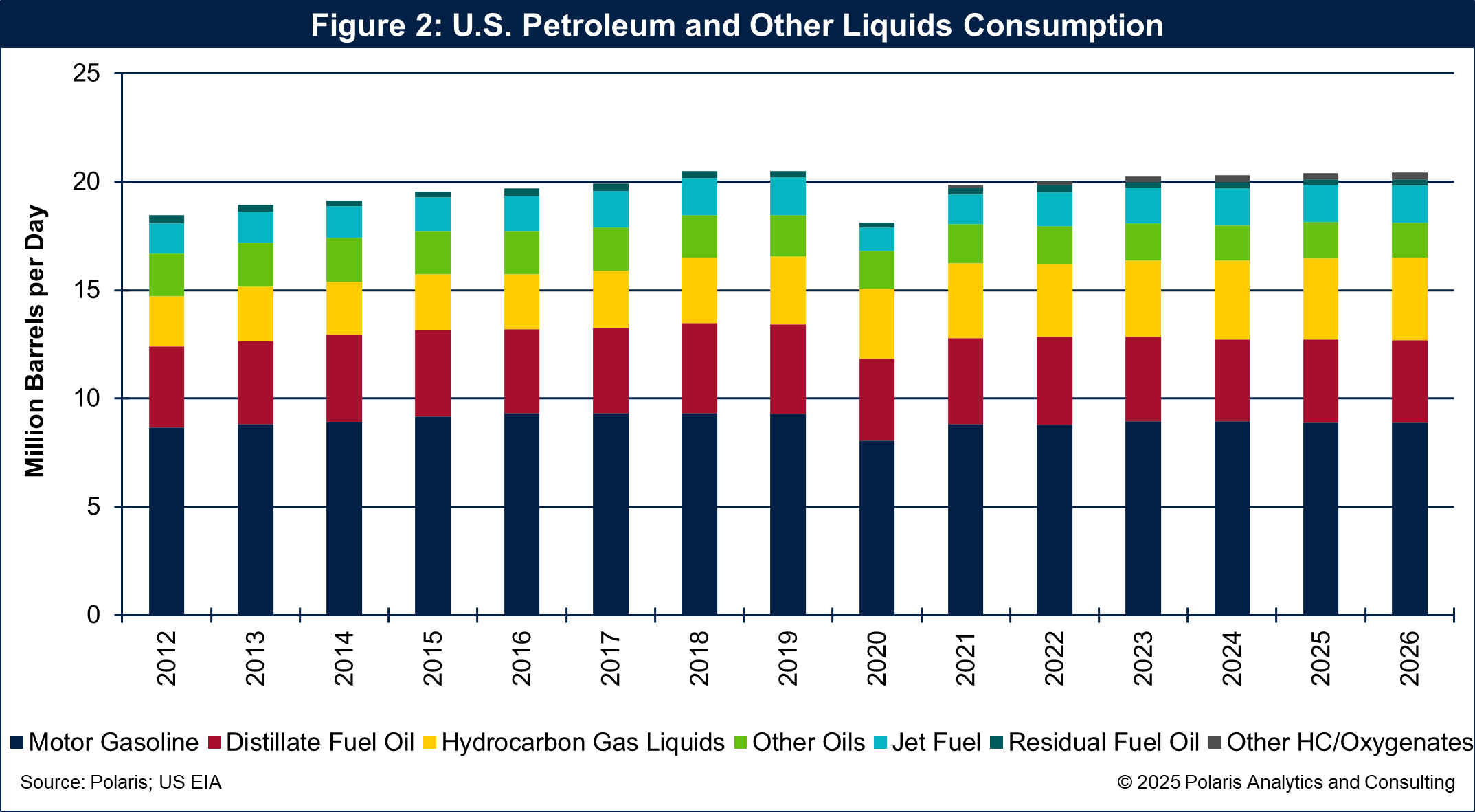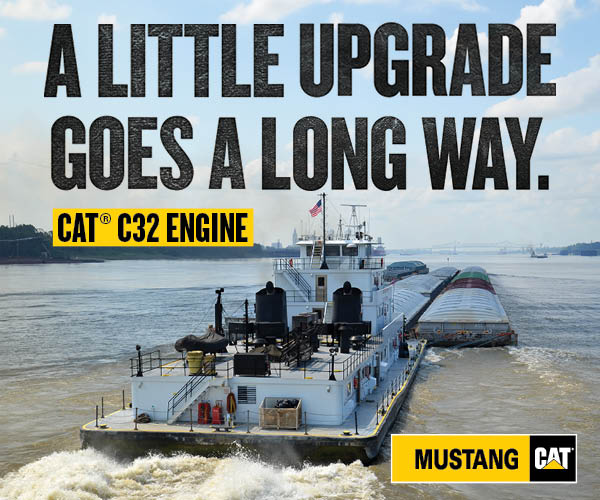The GIWW Is The Diamond Of America’s Energy Coast
The Gulf Intracoastal Waterway (GIWW), spanning 1,058 river miles from Apalachee Bay, Fla., to Brownsville, Texas, is an all-star performer. From the Mississippi River at New Orleans, the GIWW extends westward 682 miles to Brownsville, while it extends 376 river miles eastward to Apalachee Bay. Major U.S. cities along the GIWW, including Corpus Christi, Texas, and Houston, New Orleans and Mobile, Ala., are in the trade game thanks in large part to their access to the most expansive river system in the world, the Mississippi River and its supporting tributaries, enhanced by the GIWW. The canal connects all the bases of the nation’s expansive energy coast, with its high concentration of oil refineries and energy transition facilities.
Commodity Volumes
From 2012 to 2023, the GIWW moved an average of 111 million short tons of cargo annually via shallow-draft barges, peaking at 125.6 million tons in 2014 and dipping to 98.7 million in 2020, according to data from the U.S. Army Corps of Engineers. In 2023, the waterway handled 106.4 million tons, underscoring its role as a linchpin for Gulf Coast trade.
During any given year, more than 80 types of commodities are transported on the GIWW, and since 2012, there have been 105 different commodities moved. As the main artery of America’s energy coast, the GIWW’s top commodities are, unsurprisingly, energy related. Distillate fuel oil, crude petroleum, naphtha and solvents, gasoline, residual fuel oil and asphalt, tar and pitch represent one-half of the volume moved by barge on the GIWW. These are the commodities that fuel the combustible engines of the U.S. economy and pave the roads that vehicles drive on.

Cargo Is A ‘Switch Hitter’
Directionally, about 54 percent of the cargo volume moved by shallow-draft barge on the GIWW moves eastward, while 46 percent moves westward. Of the top commodities moved, more than three-quarters of the crude petroleum is barged eastward on the GIWW, while more than one-half of the volume of distillate fuel oil, naphtha and solvents and gasoline moves westward. About one-half of the residual fuel oil and asphalt, tar and pitches moves both east and west on the GIWW.
A couple of standout commodities are salt and sugar movements. Salt volumes average about 4.6 million short tons each year while sugar averages a half million. Nearly 98 percent of the salt volume and 99 percent of the sugar is moved eastward or upriver. Much of the salt is mined from the salt domes along the GIWW, while sugar is moved from sugar refineries. The salt and sugar are then moved upriver on the Mississippi River into the hinterland of the United States.
Small Ball, In A Big Way
The distance cargo is moved along the GIWW averaged 171 river miles from 2012 through 2023, from a low of 165.8 river miles in 2012 to 177 river miles in 2021. Compared to the entirety of the shallow-draft navigation channels of the Mississippi River and its tributaries, the average distance on the GIWW is short. However, the average distance is specific to the movement on the GIWW.
More than 80 percent of the cargo volume moved on the GIWW originated on another waterway, such as the Calcasieu, the Houston Ship Channel, Mobile Bay or the Mississippi River, and moved to another waterway by connecting through the GIWW. A little more than 8 percent of the cargo moved on the GIWW was destined to a berth or terminal on the GIWW, while about 10 percent was moved from a berth or terminal along the GIWW. The GIWW is an important conduit for commodities to be transported to support the vast economy of the U.S.
Tanking Brings It Home
Tank barges are a common sight and an important barge type on the GIWW, given that most cargo volume moved is liquid in form. Based on the 2025 IRR Barge Fleet Profile, there were 3,923 tank barges in the 2024 fleet, slightly less than the record fleet count from 2023. There are four types of tank barges: small tanks (10,000 barrels or fewer), jumbo tanks (10,001 to 20,000 barrels), semi-integrated (20,001 barrels or more) and other independent tank and specialty barges.
The highest concentration of tank barges is jumbo and semi-integrated. The typical tow configurations along the GIWW include a towboat pushing two tank barges and up to six barges as a dedicated tow.
Each barge type is capable of being loaded with different liquid commodities, while others are used for specific purposes moving clean or dirty, caustic, food grade and other cargo types, for example.
The core cargo volumes are experiencing a steady volume increase as the U.S. recovers from the COVID-19 pandemic. During COVID-19, petroleum and other liquid consumption across the United States dropped 13 percent as motor fuels were down due to consumers locked down at home.
Consumption levels have rebounded and are within 2 percent of pre-COVID-19 levels. The petroleum markets are resilient to play another day. For 2025, U.S. consumption of petroleum and other liquids are forecast to increase 0.4 percent and another 0.1 percent in 2026 to 20.4 million barrels per day.
For the GIWW, having a readily available supply of tank barges keeps the GIWW in the game to handle the increased volumes.

The GIWW is an important conduit connecting the energy coast of America with the upper reaches of the United States through the waterways and tributaries of the Mississippi River System. Sustained investment in GIWW infrastructure is critical to ensuring this vital waterway continues to power America’s economy.



